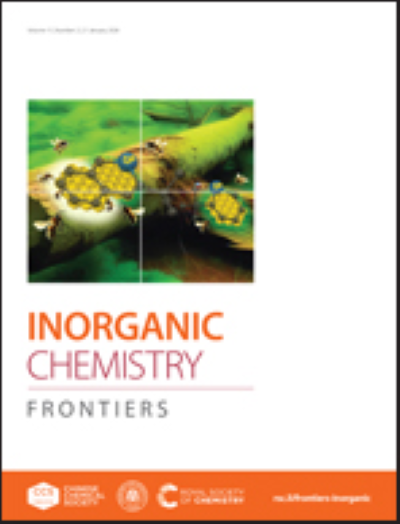强刘易斯酸(金属离子)和强BrØnsted酸的协同活化作用使KMnO4在室温下氧化CH4
IF 6.1
1区 化学
Q1 CHEMISTRY, INORGANIC & NUCLEAR
引用次数: 0
摘要
长期以来,寻找能在温和条件下氧化甲烷(CH4)的试剂一直是化学家面临的一个挑战。在这项工作中,我们报道了强Lewis酸Sc(OTf)3和强Bronsted酸CF3CO2H (TFA)在室温下激活KMnO4氧化CH4的协同作用。KMnO4在TFA/TFAA(体积比1:4,TFAA =三氟乙酸)中存在0.5-2摩尔等量的Sc(OTf)3时,能够在22℃下氧化CH4 (30 atm),以17±2%的产率(基于KMnO4)生成三氟乙酸甲酯(CF3CO2CH3)。当温度提高到40℃时,产率提高到34%。单独使用Sc(OTf)3未观察到任何产物,仅使用TFA生产了2%的三氟乙酸甲酯。使用CH4和CD4的混合物作为底物时,发现动力学同位素效应为2.2。BrCCl3作为自由基陷阱导致BrCH3的形成,表明CH3•自由基是CH4氧化的中间体。这些结果表明Sc(OTf)3和TFA与MnO4−形成一种活性中间体,MnO4−从CH4中进行氢原子抽离(HAT)生成CH3•,CH3•被进一步氧化为CH3OH。CH3OH被TFAA捕获生成CF3CO2CH3,从而阻止了CH3OH进一步氧化。DFT计算表明Sc(OTf)2+和CF3CO2H与MnO4 -结合生成活性中间体,与CH4发生HAT反应,势垒低,为12.5 kcal mol−1。本文章由计算机程序翻译,如有差异,请以英文原文为准。
Synergistic activating effects of a strong Lewis acid (metal ion) and a strong BrØnsted acid enable KMnO4 to oxidize CH4 at room temperature
The search for reagents that can oxidize methane (CH4) under mild conditions has long been a challenge for chemists. In this work, we report the synergistic effects of a strong Lewis acid Sc(OTf)3 and a strong Bronsted acid CF3CO2H (TFA) to activate KMnO4 towards the oxidation of CH4 at room temperature. KMnO4 in the presence of 0.5-2 mol equiv. of Sc(OTf)3 in TFA/TFAA (1: 4 by vol., TFAA = trifluoroacetic anhydride) is able to oxidize CH4 (30 atm) at 22 °C to produce methyl trifluoroacetate (CF3CO2CH3) in 17±2 % yield (based on KMnO4). The yield is increased to 34% when the temperature is raised to 40 °C. No product is observed using Sc(OTf)3 alone, and only 2% of methyl trifluoroacetate is produced using TFA alone. A kinetic isotope effect of 2.2 is found using a mixture of CH4 and CD4 as substrate. The use of BrCCl3 as a radical trap results in the formation of BrCH3, indicating that CH3• radical is an intermediate in CH4 oxidation. These results suggest the Sc(OTf)3 and TFA form an active intermediate with MnO4−, which undergoes hydrogen-atom abstraction (HAT) from CH4 to give CH3•, which is further oxidized to CH3OH. CH3OH is prevented from further oxidation by trapping with TFAA to produce CF3CO2CH3. DFT calculations show that Sc(OTf)2+ and CF3CO2H combine together with MnO4− to produce an active intermediate that undergoes HAT with CH4 with a low barrier of 12.5 kcal mol−1.
求助全文
通过发布文献求助,成功后即可免费获取论文全文。
去求助
来源期刊

Inorganic Chemistry Frontiers
CHEMISTRY, INORGANIC & NUCLEAR-
CiteScore
10.40
自引率
7.10%
发文量
587
审稿时长
1.2 months
期刊介绍:
The international, high quality journal for interdisciplinary research between inorganic chemistry and related subjects
 求助内容:
求助内容: 应助结果提醒方式:
应助结果提醒方式:


